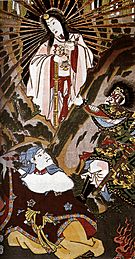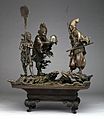Japanese dragon facts for kids
A Japanese dragon, also known as ryū or tatsu, is a legendary animal from Japan. These amazing creatures are often shown as large, snake-like beings. They are similar to dragons found in Chinese and Korean stories.
Japanese dragons are related to the Chinese lóng and the Korean yong. Like other Asian dragons, they are usually shown without wings. They have legs with claws. They often live in the ocean, in clouds, or in the heavens. Japanese dragons do not fly as often as Chinese dragons. This is why they often look more like serpents. In art, the ryū usually has only three toes. Chinese dragons often have five, and Korean dragons have four.
Japanese dragons often live in the sea. This makes sense because Japan is an island nation. The sea is a big part of its geography.
The idea of the ryū came from China. It is one of the four special creatures from the heavens in Japanese mythology. The other three are the phoenix, the turtle, and the tiger. The Japanese dragon has often been a symbol for the Emperor or for a great hero.
Dragons in Japanese Mythology
In Japanese mythology, one of the first dragons mentioned is the Yamata-no-Orochi. This was a very large serpent with eight heads and eight tails. A hero named Susanoo defeated this serpent. He tricked the creature into drinking too much sake (rice wine) before he killed it.
Later Japanese stories often show dragons as good creatures. This might be because of influence from Chinese culture. For example, in the story of Urashima Tarō, the main character saves a turtle. This turtle turns out to be the daughter of Ryūjin. Ryūjin is the powerful dragon king of the ocean.
Related pages
|
Mythic Texts and Folktales: |
Images for kids
-
A Japanese sea-dragon, by Utagawa Kuniyoshi.
-
A Japanese dragon, by Hokusai.
-
Princess Tamatori steals the Dragon King's jewel, by Utagawa Kuniyoshi.
-
Emperor Antoku's grandmother rescuing him from a dragon, by Yoshitsuya Ichieisai.
-
A dragon goes up towards the heavens with Mount Fuji in the background. This is from an 1897 ukiyo-e print by Ogata Gekkō.
-
Kiyohime Changes from a Dragon into a human woman, by Yoshitoshi Tsukioka.
-
The Dragon King's daughter. Her father lives at the bottom of the sea. By Utagawa Kuniyoshi.
-
Susanoo slaying the Yamata no Orochi, by Kuniteru.
-
A dragon teapot from the Walters Art Museum.
See also
 In Spanish: Dragón japonés para niños
In Spanish: Dragón japonés para niños














